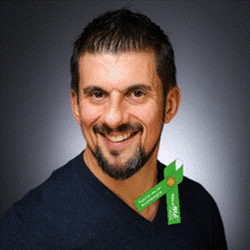Ahead of EHS Congress, taking place in Berlin in May, SHP catches up with one of the event’s speakers, Rob Stephenson, who is CEO and Founder of FormScore.
Rob’s mission is to inspire the creation of mentally healthy workplaces where people feel equipped and empowered to prioritise wellness. The mission is personal. Rob experiences bipolar disorder and sharing his story in 2015 led him to dedicating his career to becoming an agent for change in the workplace.
Despite progress in workplace wellbeing over recent years, negative workplace stress and burnout are all worsening, according to Gallup data. Rob says stigma is still an issue and, as a result, many people struggle in silence. He feels strongly that we still need to work hard to create safe spaces for people to seek help.
In 2020 Rob set up FormScore, an analytics and wellbeing platform designed for managers. It evolved out of a tool given to Rob by his therapist about 15 years ago, which he used to track and manage his own mental wellbeing (with a daily mental health score out of 10 and comments about what was driving it).
In this interview Rob shares some of the trends he sees in the FormScore data, shining a light on the biggest challenges managers are having when it comes to managing workplace wellbeing. He also shares his thoughts on what you can do if you’re a health & safety professional struggling to convince senior executives of the importance of taking this seriously.
Charlotte Geoghegan (CG): FormScore collects individuals’ data about what drives wellbeing and effectiveness, highlighting limiting factors and enablers. What general trends do you see from the real-time data?

Rob Stephenson
Rob Stephenson (RS): The number one negative driver of workplace wellbeing is workload. Work-related stress is linked to that. In a lot of cultures, we’re trying to do more with less and people are feeling very stressed and very busy. The latest thinking on workplace wellbeing is you can put a lot of solutions in place which are great. But actually, we’ve got to start fixing work; work is a key determinant of wellbeing.
The number one positive driver is having a sense of belonging, when employees feel they’re doing meaningful activity and have a purpose.
Flexibility comes in a little bit, but not as much as you might think. The same with pay. These factors don’t tend to be top of the list.
A sense of belonging and inclusion and some of those factors that are important on a personal level have a huge impact.
Sleep is always both a positive and negative. It’s very prominent, along with exercise and social connections.
We don’t review personal data by the way, that is kept confidential. All we look at is general trend data.
CG: You say wellbeing should or could be considered a core component of high performance and an essential driver of employee engagement. Can you expand on that?
RS: Yeah. So, let’s look at the maturity model of mental health and wellbeing in the workplace. Initially we looked to support people who are struggling with mental illness. The issue is when you look at people who are struggling, you’re only hitting a small proportion of the workforce. So how do you engage everybody else? Why should you invest in wellbeing at a team level or a manager level? Why should you care about the wellbeing of all your people, apart from because it’s the right thing to do at a human level?
Academics and exciting emerging data will tell you that wellbeing is an essential component of performance. And if you think about it, it’s got to be right. We’re never going perform at our best if we haven’t slept well, if we’re not eating well, if we’re not balancing stress with moments of recovery, if we’re not taking our holiday. We’d be overloaded, exhausted and burnt out – which a lot of people are.
And by the way, I think the health and safety community have been brilliant at grabbing onto this, forcing change within organisations. I’ve seen some of the best workplace wellbeing initiatives driven by the health and safety community.
CG: How would you convince sceptical, executive leaders who view wellbeing as a nice-to-have, soft & fluffy discretionary benefit issue?
RS: Show how this impacts shareholder return.
There’s a great study being done with the jobs board Indeed. They have allowed employees to go and rate their employer on wellbeing. Like Glassdoor for happiness, it’s employee reported (for wellbeing). They’ve got about 15 million data points. (A lot of it in the US.)
Using that data, you can track the correlation between wellbeing performance and stock market performance. What’s clear is the organisations with high wellbeing scores significantly outperformance those that don’t. So, for convincing sceptical leaders, this is probably one of the best metrics you can use do that.
I feel that we’ve reached a watershed moment with data. We’re approaching a tipping point where we can really back-up investment in wellbeing.
There’s also a useful report out from Business in the Community. They had a roundtable where CFOs and McKinsey Health Institute came together to quantify the value of the opportunity of getting this right. So not the cost of mental ill health, but the value created if we invest properly in creating cultures that are conducive to wellbeing, and the numbers are huge. The return dwarfs the costs. So again, I think when you start getting CFOs on board with this, show them that this is an investment decision as opposed to a benefit or a cost decision. And that’s a game changer.
You can also look at your figures around absenteeism, turnover etc. My only reticence there is we’ve had that data for years and it’s not moved the dial far enough. Some senior leaders will accept a certain level of abseentism and will consider some workplace stress as inevitable.
CG: Who is doing this well?
RS: I’ll give you three examples.
The first is Osborne Clarke, a law firm. Rather than just putting a bunch of solutions in place, they did a deep listening exercise of their employees. They wanted to understand the causes of negative stress in the workplace, burnout, and lack of psychological safety. Then they delved into those drivers, those determinants. They looked at which ones they could influence. Then they worked on a three-year plan. So a relatively long horizon, because this stuff can’t be fixed quickly.
The second is BT. They did a great study with Oxford University at one of their call centres. They measured wellbeing as well as output and performance. They cross-referenced the data and found that the call centres with better workplace wellbeing were significantly outperforming others.
Finally, you can always look to the likes of Unilever because they’ve been doing this well for a long time. They’ve aligned purpose with employees and they’re going a step beyond that, looking into their supply chain and the communities that they operate in, finding ways they can have a positive influence.
CG: Why have you chosen to speak at the EHS Congress?
RS: It’s such a good event and I’ve got a lot of respect for what health and safety professionals do in this space. I like to influence those that are making change and my goal here is to equip this this group with some fresh thinking, some data and personal reflection. It will be a highly interactive session to that they can go back to their workplaces well-equipped.
When it comes to workplace wellbeing, my belief is that many of the forward-thinking companies are at Everest base camp. We’re high up, but we’ve still got Everest to climb. We’re trudging through the foothills, trekking away. My hope with the conference is that there’s a great group of people there whose journeys I can help to speed up a little bit.
Why should you subscribe to the SHP newsletter?
Do you want the very latest health and safety news, product launches, job listings and expert opinions sent straight to your inbox daily?
The SHP newsletter is essential reading – sign up today to get your hands on all this!


